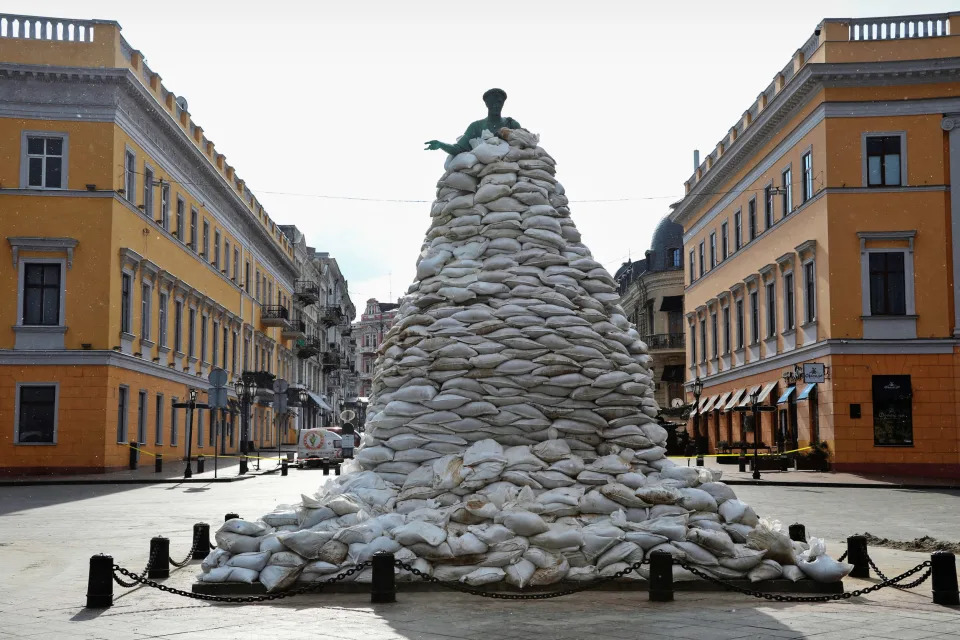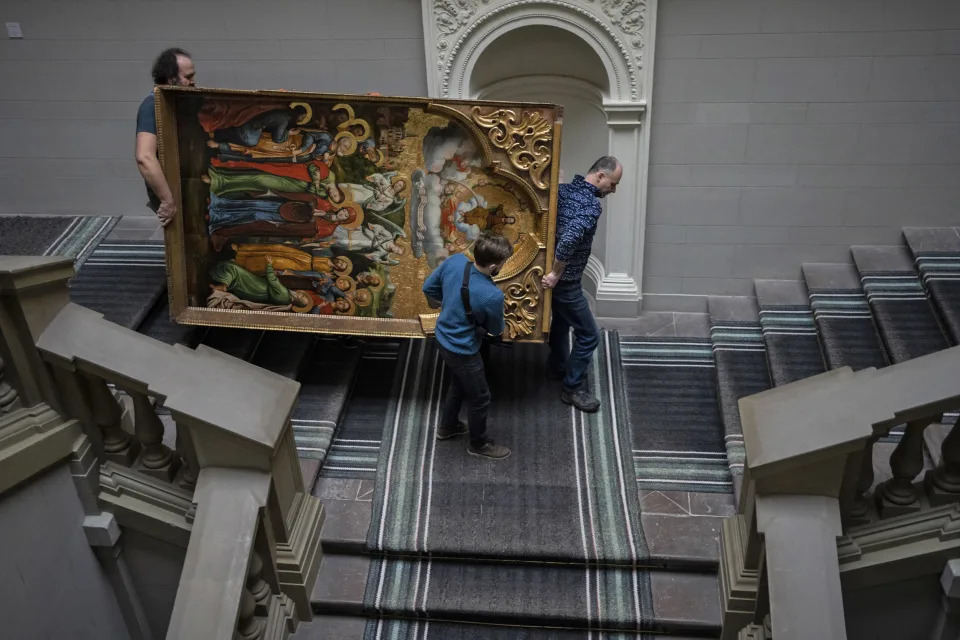NBC News
Some Ukrainians believe Russia is targeting landmarks to erase country from the map
Kharkiv’s Fine Arts Museum was locked up tight and the workers had gone. It was after midnight on March 3, a week after the Russian army had invaded Ukraine. The two-story museum, with its 25,000 works of art, had seen no damage.
That changed in an instant. A Russian shell exploded nearby, shaking the building and shattering all its windows. Fortunately, the museum’s director, Myzgina Valentyna, and her staff had taken down the art and moved it to a secure location.
Kharkiv’s 17th century Holy Dormition Cathedral was not so lucky. A day before the museum was hit, Russian forces shelled the cathedral as residents hid inside. While no civilians were injured, the attack destroyed the church’s stained-glass windows and badly damaged some decorations.
Valentyna told NBC News the museum cannot be repaired right now. “The situation in the city is very, very difficult,” she said.

Ukraine is home to seven UNESCO World Heritage Sites, and since the Russians launched their invasion, at least 39 landmarks across the country have been damaged, looted or reduced to ruins, according to the Transatlantic Dialogue Center, a Ukrainian political nonprofit based in Kyiv. On March 23, Mariupol’s city council confirmed via Telegram that the Russian military destroyed the city’s Arkhip Kuindzhi Art Museum, housing over 2,000 exhibits and an extensive collection of works by prominent Ukrainian artists. The fate of the artwork remains unclear.
Targeting historic monuments and cultural heritage sites is a war crime under international law, according to The Hague Convention of 1954. But that all seems to be part of Russia’s plan, some cultural authorities say. “They just want to erase from the map Ukraine — our heritage, our history, our identity and Ukraine as an independent state,” said Iryna Podolyak, Ukraine’s former vice minister of culture, who said Russia’s military seems to be targeting cultural heritage sites in addition to houses, hospitals and schools.

Collateral or intentional damage?
Russia’s military tactics have made it harder to determine whether landmarks are being specifically targeted or whether damage is a byproduct of attacks on the civilian population. Russian forces have shelled nonmilitary areas from long distances in an attempt to demoralize Ukraine and drive civilians out of cities.
Russia has framed the invasion as a rescue of ethnic Russians and a purge of “Nazi” elements from a territory where it has blood and family ties.
Russian Foreign Minister Sergey Lavrov told U.N. diplomats via video message on March 1 that “as President Vladimir Putin has repeatedly emphasized, we treat the Ukrainian people, their language and traditions with unfailing respect.”
But on Feb. 21, Putin said in a speech, “There is no nationhood in Ukraine. … Contemporary Ukraine was completely created by Russia … by Soviet Russia.”
Yohanan Petrovsky-Shtern, a professor in Jewish studies at Northwestern University, believes the damage is both collateral and intentional, but “is more likely to be called deliberate destruction.” He notes that Russian authorities have been confiscating textbooks on Ukrainian history from libraries in occupied areas and burning them.
“Putin is absolutely confident, as many Russian bureaucrats [were] in the 1860s,” said Petrovsky-Shtern, “that Ukrainian language doesn’t exist, that Ukrainian people do not exist, that Ukraine is a nonentity and can never be sovereign because there is no such country as Ukraine.”
By leveling the country’s landmarks, some experts argue, Putin will try to redefine Ukraine’s history and culture as Russian. “If we are speaking about Russian politics, during the last few years, we could say that the Russian president and government says there is no Ukrainian culture and everybody is all Russian,” said Igor Kozhan, director general of the Andrey Sheptytsky National Museum in Lviv.

This reappropriation is part of Putin’s justification for his war of choice, a belief that Ukrainian cultural experts assert is pure fiction. “It is just the imagination of a sick person,” said Podolyak.
Ukrainians have also hurled the Nazi charge right back at the Russians, as they did Saturday after Russia allegedly damaged an important reminder of genocide. The Ukrainian Ministry of Defense tweeted on March 26 that the Russians had “fired on and damaged” the Holocaust Memorial at Drobitsky Yar, site of a German massacre of approximately 15,000 Jewish civilians during World War II. “The Nazis have returned,” said the tweet. “Exactly 80 years later.”
Protecting landmarks
As Ukraine’s museums, monuments and heritage sites come under siege, Ukrainians are banding together to protect their landmarks. Peter Voitsekhovsky, an analyst at the U.S.-Ukraine Foundation, a nonprofit, said residents in Odesa had piled sandbags around the city’s famed 19th century Opera House and the iconic statue of Odesa’s founder, the Duke of Richelieu. Voitsekhovsky said that for Odesans, the Richelieu statue holds the same significance as the Statue of Liberty does for Americans. “With Ukraine’s rich history, there are so many places that are symbols for the soul of the nation,” he added. “But you cannot cover the whole country with all its temples, monuments and churches with sandbags.”
In Lviv, a city in western Ukraine that dates to 1237 and is a UNESCO world Heritage site, workers have covered historic statues in protective materials, installed metal sheets over the stained-glass windows in the town’s Latin Cathedral and removed religious icons from the churches. As the Russian army smashed across the border on Feb. 24, Igor Kozhan’s staff sprang into action, securing the windows, strengthening the walls and transporting the National Museum’s collection to a safe place.

Kozhan also helped draw plans to move the collection out of Ukraine to museums in Western Europe as needed. But he believes “the Russian army won’t be shown on our city streets.”
One of the most important heritage sites in all of Ukraine is St. Sophia’s Cathedral in Kyiv. Over 1,000 years old, this gold-domed church was once the center of Ukrainian Orthodox Christianity and is home to a spectacular collection of frescoes, icons and mosaics. But one mosaic stands out. It depicts the Virgin Mary on a gold background with her hands raised toward the sky.
Yuri Shevchuk, a lecturer of Ukrainian at Columbia University, explained that Ukrainians refer to this mosaic as the “Indestructible Wall.” Local legend says that as long as this wall remains standing, Ukraine will never perish.
